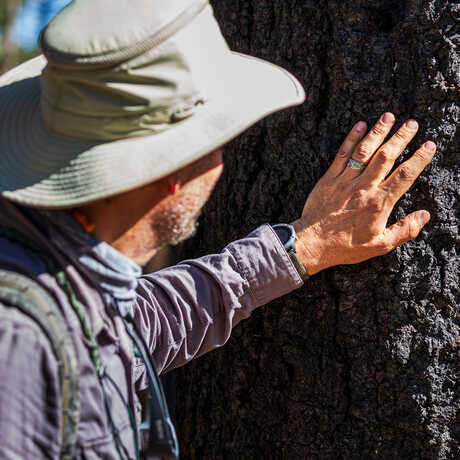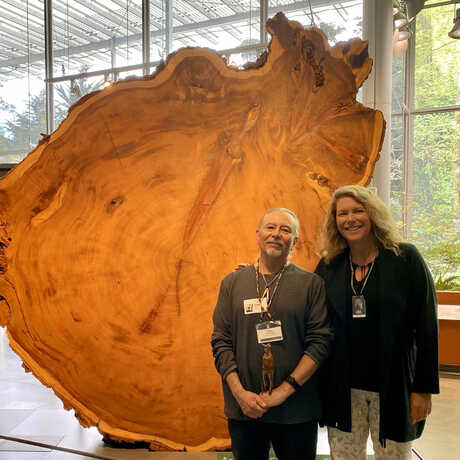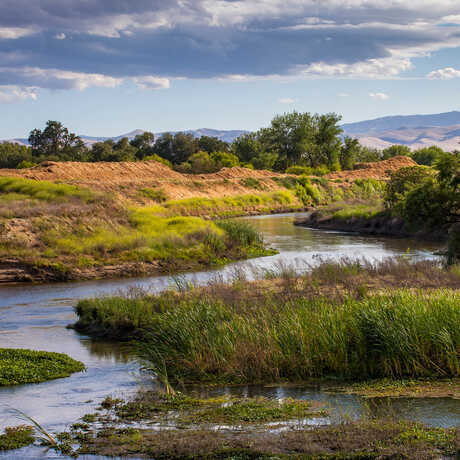Sparking Regeneration With Indigenous Science

Well before Californians became accustomed to massive, destructive wildfires, Indigenous peoples across the West Coast lit low-intensity fires throughout forestlands and brush.
Called cultural burning, this practice is both a crucial ecological tool and a longstanding cultural custom for Native communities like the North Fork Mono, a Tribal band located in and around what is today Mariposa County, California.
By burning small patches of land, cultural burns mimic natural disturbances in the land, clear fire-prone brush, and stimulate the growth of native plants. In Mariposa, located in the foothills of the Sierra Nevada mountains roughly between Fresno and Modesto, dozens of recently completed burns have nourished fire-following flowers and, perhaps counterintuitively, brought water back to parched meadows and landscapes.

This November, during Native American Heritage Month, we’re highlighting the importance of Indigenous Science and Native culture in our approaches to California conservation—and the individuals working to incorporate traditional ecological knowledge into wildfire management today.
This blog follows a weekend-long cultural burn, hosted in Mariposa by North Fork Mono Tribal leader Ron Goode and attended by Cal Academy staff and partner organizations from across the state.
On the first day of the cultural burn, attendees gathered in a circle on a deergrass meadow for an opening ceremony, in which Goode explained the significance and history of burning in California. The lands we sat on were both the ancestral homelands of the North Fork Mono, and the private property of Goode and his wife.
“Land calls Fire, together they call Wind, and they bring Water,” says Goode, repeating an adage that explains the intertwined relationship between fire and the landscape.

At this one gathering, Tribal communities from across the country were represented. Scientists and students from Stanford, University of California schools, and Sonoma State came to learn. Film crews from the Bureau of Land Management, Indigenous videographers, and the Academy attended to document the experience.
For Goode, this cultural burn was a crucial opportunity to pass down his knowledge and experiences as a Tribal elder to a wider audience.

Fire has historically been an integral part of Indigenous culture in California; indeed, Native Californians used to light low-intensity fires so often that they burned more land than is razed by megafires today. But throughout the 19th and 20th centuries, U.S. officials increasingly suppressed these burns, creating the overgrown, megafire-ripe conditions we see in western forests today.
Goode and other Native Californians are now at the forefront of efforts to reincorporate these intentional, ecosystem-balancing burns in the state’s approach to wildfire. By working in tandem with forest management and other Tribes, Goode and traditional fire practitioners plan to expand these burns from private lands to state and federal properties.

But it’s not just about bringing fire back to the land. Though land managers have increasingly turned to prescribed burns to reduce fuel loads, cultural fire is different: Native Californians have applied these burns for millennia to enhance plant ecosystems and cultivate materials used in other cultural practices, such as medicine, foodways, basketry, and more.
Back at the burn site in Mariposa, leadership convened to discuss cross-organizational collaborations while practitioners started surveying meadows and fields for ideal burning grounds. They settled on an oak grove packed with dried sourberry bushes, near patches of previously burned plots that were ready to be watered and tilled.
Nearby, Goode says a newly rejuvenated spring and a meadow of flowers popped up after years of intentional burns. White, yellow, and purple flowers dotted the landscape, indicating the return of water to formerly parched and overgrown lands.
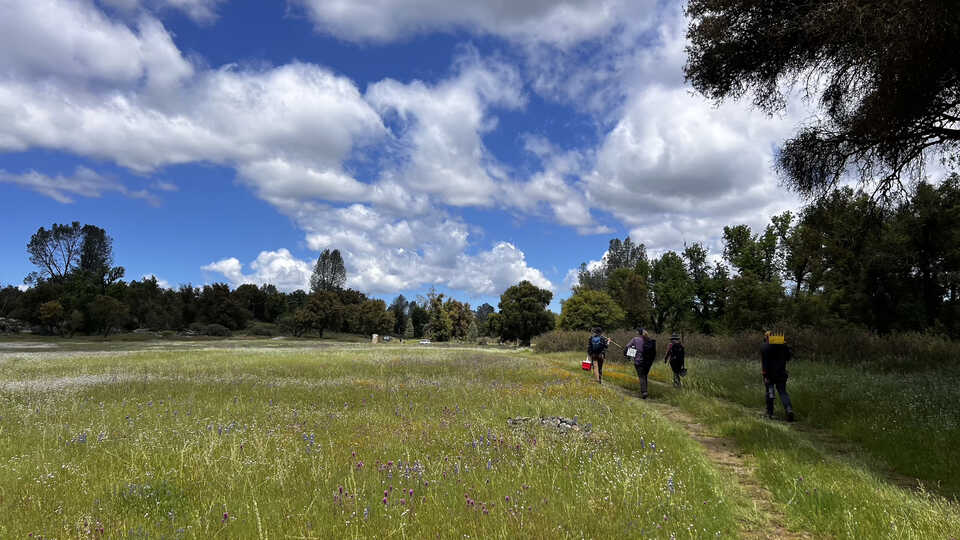
Participants trek to the burn site, located near a cluster of oak trees. Liz Lindqwister © 2024 California Academy of Sciences

Designated burn leaders directed newer participants to cut brush and build burn piles. Liz Lindqwister © 2024 California Academy of Sciences
Armed with pruning shears, rakes, and saws, burn participants started chopping down sourberry bushes and fallen logs, tossing twigs and other waste onto nearby piles. A chainsaw roared to life as more experienced practitioners felled dead trees and added logs to the piles.
Each pile of brush was carefully set on fire, while participants continued adding more fuel and tending to the crackling piles, extinguishing any flames that escaped onto the towering oak trees.


Participants used water bladders to contain the fires and extinguish burn piles. Molly Michelson © 2024 California Academy of Sciences
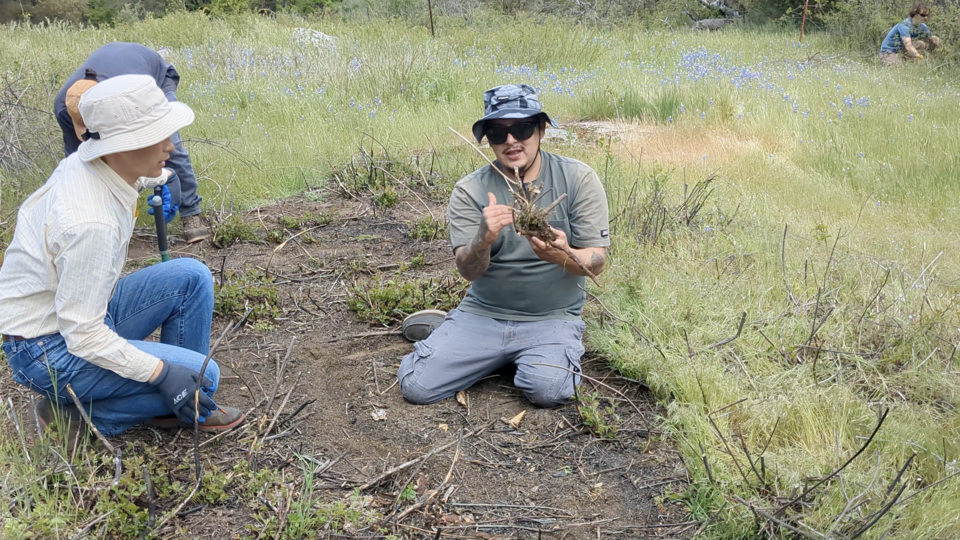
Jesse Valdez teaches a burn participant how to properly shear bushes, near its roots. Molly Michelson © 2024 California Academy of Sciences
When the sun started setting, participants equipped with bright yellow bladders full of water hosed down the fire piles. Others used rakes to push around ashy remains and snuff out any lingering flames, until all that remained was a thin trail of smoke coming from the ground.
Goode, now in his 70s, hovered nearby to survey the ongoing burns. His best advice? Go slow, take your time, and enjoy the day.

What personal protective equipment do you wear to a cultural burn? All participants donned cotton shirts and pants to prevent the fire and any wayward ashes from melting their clothing. Long sleeves, hats, and gloves were a must, to protect from the sun and sharp twigs.
Molly Michelson © 2024 California Academy of Sciences
Early morning the next day, the same group of practitioners revisited the burn site and began the process of tilling over the ground. Using rakes, shovels, and water bladders, burn participants incorporated the remaining ash into the soil to help fertilize the roots below and promote the growth of new plants and flowers.
Jesse Valdez, an experienced practitioner and Goode’s grandnephew, showed how the tilled-over grounds should transition from white ash into a sooty purple color, before ending as a brown patch of raked dirt.
Goode says that the ecological benefits of this burn, which was carried out in April, will benefit the gatherers in his community. Often women, gatherers will revisit these same meadows to collect dried native plants like deergrass, used in woven baskets and other hand-made goods.

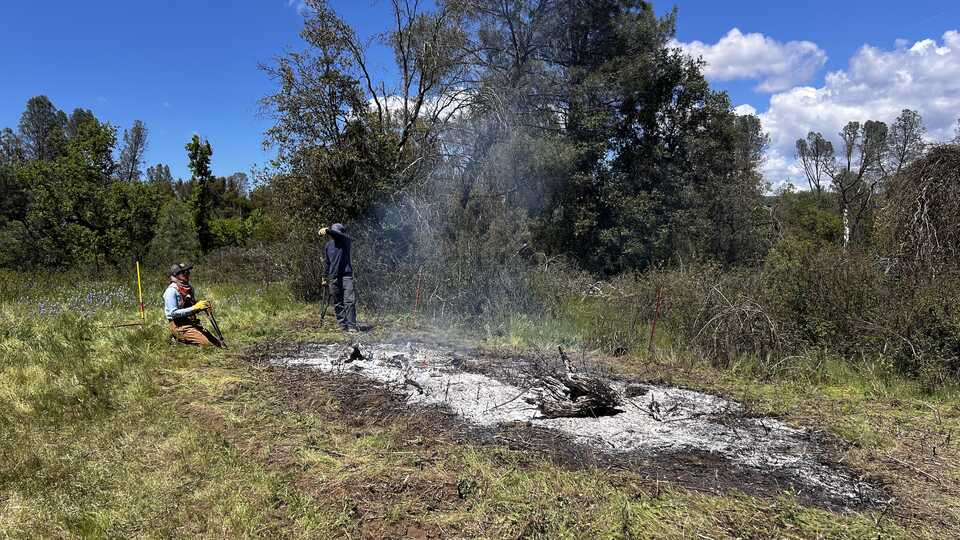
Newly burned piles turn a bright white color, since the ash sits at the soil's surface. Liz Lindqwister © 2024 California Academy of Sciences

A patch of brown soil, shown after raking and incorporating the ash. Molly Michelson © 2024 California Academy of Sciences
Seeing the diversity of perspectives represented by the participants—storytellers, community members, elders, scientists, government workers, and volunteers alike—underscored the need for collaboration and community building as we strive to restore our state’s ecosystems.
It reminded me of nascent efforts in science to infuse Western and Indigenous knowledge, creating space for multiple ways of seeing and knowing the natural world. While Academy scientists have already applied their experience in biodiversity research to prescribed burns in the Sierras, for example, we stand to learn much more from the regenerative work being done by Native partners in California, and the ages-old practice of cultural burning.

Learn more about fire resilience and Indigenous Science at Cal Academy:
- Native American Heritage Month: Celebrate NAHM by supporting local Indigenous organizations and exploring Indigenous stories at the Academy.
- California: State of Nature: Visit our newest exhibit highlighting Native perspectives on California conservation and ecosystems.
- Native Californian stories: Watch our multi-part series highlighting Native perspectives on topics ranging from coastal restoration to grizzly bears.
- Traditional Ecological Knowledge: Learn about Indigenous Science and the importance of multivocality in scientific research.
- Caples Creek research: Learn about this multi-year project on prescribed fires and forest biodiversity in Northern California.

